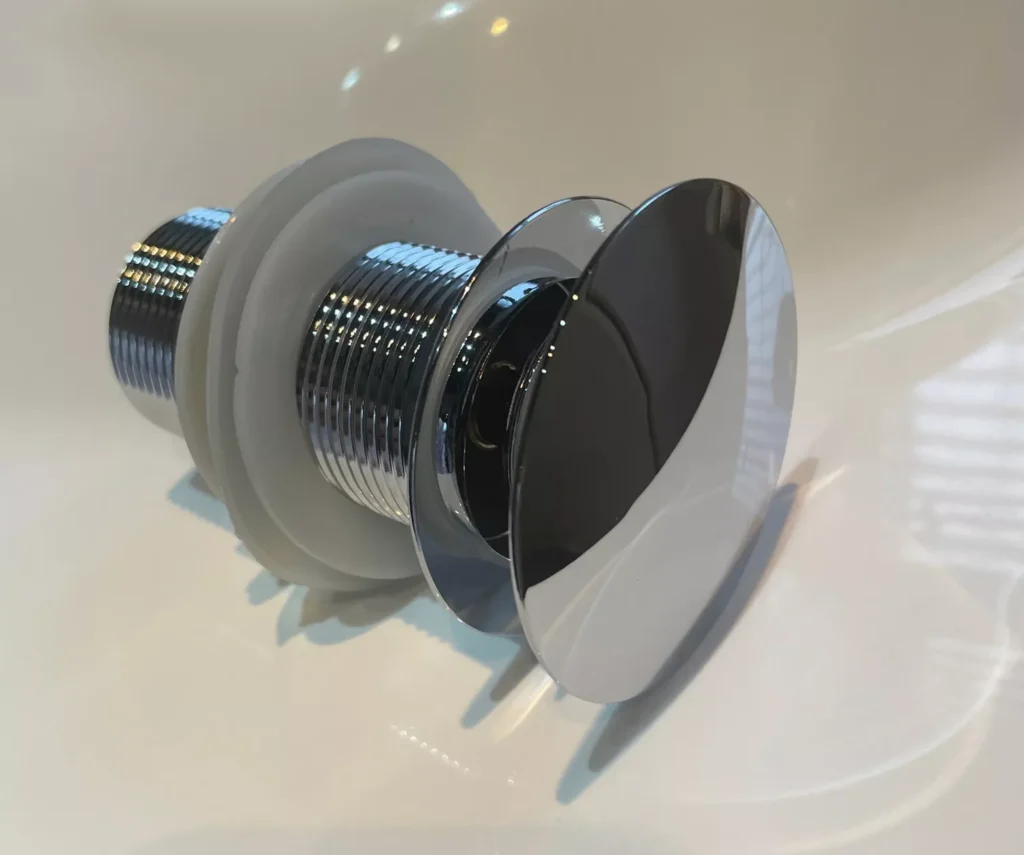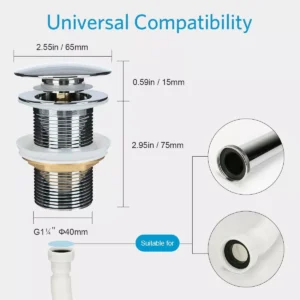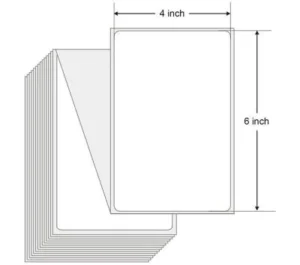Indeed, in modern bathrooms, the basin waste (the drain assembly at the bottom of the sink) plays a vital role. For example, basin wastes typically fit a standard 1¼-inch (about 32mm) drain opening. In fact, they are often made of durable metals like brass, copper or stainless steel, chosen for corrosion resistance and longevity.
Specifically, two common types of basin waste are click-clack wastes and pop up basin wastes basket. Therefore, understanding how each type works helps homeowners choose the right waste for their sink.

What is a Click Clack Basin Waste?
Essentially, a click-clack waste is a contemporary drain stopper with a spring-loaded, push-button mechanism. Specifically, pressing down on the top cap closes and seals the drain; then pressing it again releases the seal and opens the drain. As a result, this push-to-open style is named for the satisfying “click-clack” sound it makes during operation. Internally, the cap covers a hidden spring and stopper assembly.
Specifically, when the cap is depressed, the spring compresses and locks the plug down. Pressing again releases the spring and causes the plug to pop back up. Consequently, this design lets the sink fill up when closed and drain instantly when opened. In practice, you simply press once to seal and press again to empty. Hence, click-clacks allow easy filling of the basin for tasks like hand-washing or shaving and one-touch draining when finished.
Moreover, click-clack wastes come in two main styles: slotted (for basins with an overflow) and unslotted (for basins without an overflow). For instance, slotted wastes have a side cut-out slot allowing excess water from the sink’s overflow hole to drain away even when the stopper is closed. As a result, this prevents accidental flooding if the tap is left running. Conversely, an unslotted click-clack waste is fully sealed and suited for overflow-less basins, such as many vessel or countertop sinks.
Advantages of Click Clack Wastes
- Easy Operation: Just push to close and push again to open, making it extremely user-friendly.
- Sleek Appearance: The flat, cap-style design provides a minimalist look without any visible chain or lever.
- Reliable Mechanism: With fewer moving parts, the click-clack design tends to be very durable. In fact, one guide notes these wastes are “reliable and easy to look after.”
- Wide Availability: Click-clack wastes have become common in new bathrooms. They come in many finishes (chrome, nickel, brass, black, etc.) and shapes and fit any standard 1¼” drain.
- Hygienic: Operation is mostly hands-free (aside from pressing the cap), so users touch only the clean cap surface rather than reaching into the drain.
- Compatibility: Slotted click-clack wastes work with basins that have an overflow, providing built-in protection against spills.
- Low Profile: The cap sits nearly flush with the basin surface, minimizing the waste’s height under the sink.
- Popularity: They are widely adopted in modern designs; one retailer even calls click-clacks “arguably the most popular basin waste style currently available.”
Disadvantages of Click Clack Wastes
- Hand Contact Required: You must press the waste cap with your hand to operate it, meaning your hand gets wet if water is standing in the basin.
- Possible Jamming: Hair and debris can collect around the stopper or spring. Occasionally the mechanism may stick if not cleaned.
- Cost: Click-clacks can be slightly more expensive than basic stopper designs due to the integrated mechanism and plated finishes.
- Sealing Limitation: Some lower-end models may not seal as tightly as a dedicated rubber plug, potentially allowing a small drip; high-quality units mitigate this issue.
What is a Pop Up Basin Waste?
Essentially, a pop up basin waste is a classic drain stopper design operated by a lever (or rod). Often integrated with the faucet, a pop-up works by connecting to a pull-up rod at the back or on top of the tap. For example, when you lift the lever up, the internal rod drops the stopper disc into the drain to seal it. Subsequently, pushing the lever down lifts the stopper, allowing water to flow out. Internally, the rod connects via a pivot joint and clevis to the stopper plate.
For example, many faucets have a small lever protruding from the rear. Lifting this lever causes the stopper inside the basin to close, while pressing it releases the plug. Consequently, you never need to touch the drain plug with your hands – the tap’s lever does the work. However, it requires enough space under the faucet for the rod and linkages, and over time some of these parts (like the pivot or seals) may wear out.
Advantages of Pop Up Basin Wastes
- Hands-Free Operation: You lift or push the faucet’s lever, so you do not need to touch the drain cap with wet hands.
- Hidden Mechanism: All moving parts are concealed under the basin. No chains are visible, and the faucet maintains a seamless appearance.
- Integrated Design: Pop up basin waste drains are often included with matching faucets. If your faucet has a built-in pop-up lever, the mechanism is already compatible, simplifying installation.
- Classic Style: Many homeowners appreciate the traditional look and feel of a lever-operated stopper. It suits vintage or classic faucet styles.
- Strong Seal: The pop-up stopper disc often seals very tightly against the drain, securely holding water when closed.
Disadvantages of Pop Up Basin Wastes
- Mechanical Complexity: The pop up basin waste has multiple parts (rod, pivot ball, clevis, seals). More parts mean more potential failure points. For instance, the rod or pivot can loosen or break.
- Tricky to Clean: The internal linkage and underside of the stopper can accumulate hair and grime. Cleaning a pop-up waste often requires disassembling the pivot under the sink.
- Leak Potential: Because it relies on both the stopper seal and the pivot assembly, there’s a higher chance of leaks if any seal degrades. Over time, small drips may occur if the stopper or linkages loosen.
- Space Requirement: The pop up basin waste mechanism requires clearance under the sink for the rod and pivot, which can complicate installation in tight spaces.
- Faucet Requirement: A pop-up waste only works with a compatible faucet. If your sink has a single-hole mixer without a pop-up lever, you cannot use a pop-up waste without changing the faucet.
Click Clack vs Pop Up Basin Waste: Key Differences
In summary, these two waste types differ in how they operate:
| Feature | Click Clack Waste | Pop Up Basin Waste |
| Operation | Push-button: press the cap to close or open the drain. | Lever rod: pull/push the faucet lever to drop or lift the stopper. |
| Mechanism | Spring-loaded stopper inside the waste body. | Rod and pivot assembly under the faucet. |
| User Contact | Requires touching the top cap (hand gets wet if water is present). | Operated by lever; hands stay dry because the plug is moved internally. |
| Appearance | Sleek and flat. No chains or visible levers. | Traditional look; visible lever/knob on faucet (but no chain). |
| Installation | Universal: fits any sink (1¼” thread). Available as slotted or unslotted for basins with or without overflow. | Specific to faucet: must match a faucet with a pop-up rod. Typically part of a faucet assembly. |
| Maintenance | Fewer parts; generally easy to clear debris by removing the cap. | More parts to service; may need periodic adjustment of rod or cleaning of linkage. |
| Suitable For | Modern, minimalist sinks. Ideal for single-mixer taps or where easy push control is wanted. | Traditional or 3-hole sink setups. Works if your faucet has an integrated pop-up lever. |
| Pros | – Simple, intuitive use – Durable and low maintenance – Uncluttered, modern look | – Hygienic (no hand contact) – Familiar mechanism – Secure seal when closed |
| Cons | – Hand must press waste (wet hand) – Potential for jamming if debris enters | – More moving parts (rod, pivot) can fail – Harder to clean – More leak points over time |
Choosing the Right Basin Waste
Ultimately, the right choice depends on your sink, faucet, and personal preferences. For example, if you have a sleek, modern sink or a single-lever mixer, a click-clack waste is often preferred. It pairs well with minimalist designs and covers most sink types. Conversely, if your faucet has a built-in pop-up lever (common in 3-hole basins) or you want completely hands-free operation, a pop-up waste may be more suitable.
Additionally, consider cost and upkeep. Click-clacks may cost slightly more upfront, but with simpler internals they generally need less adjustment over time. Pop-ups can require small tune-ups (tightening the linkage or replacing a seal) as they age. Moreover, always match the waste to your basin’s overflow feature: a sink with an overflow must use a slotted waste, whereas a sink without overflow needs an unslotted one. Finally, check materials and finish: a quality waste will be made of brass or stainless steel to resist corrosion and match your décor.
Specifically, for those still deciding, consider these practical points. For instance, if your faucet is a single-hole mixer, a click-clack waste will fit easily without needing an extra lever. Conversely, if your faucet includes a pop-up lever, sticking with a pop up basin waste can simplify installation. Also, think about maintenance: some people find it easier to remove a click-clack stopper to clear hair, whereas a pop-up often requires reaching under the sink to service. In any event, always ensure the waste matches your faucet style and basin overflow. In essence, both systems do the same job with different user experiences, so the best one depends on your setup.
For example, many older sinks used chain-and-plug stoppers; click-clack and pop up basin wastes are modern alternatives to those systems. In fact, if replacing an old chain waste, you can usually install a click-clack in the same hole (no lever needed), whereas adding a pop-up would require a faucet with a rod. Ultimately, both designs meet the same plumbing needs. Comparing their features and your bathroom’s design will guide you to the right choice.
Maintenance and Cleaning
In general, both click-clack and pop up basin wastes require occasional cleaning to remove hair and soap residue. For example, you can often remove the stopper for cleaning: many click-clack tops pop out or unscrew to access the drain. Similarly, pop-up stoppers can usually be taken out by operating the pivot mechanism under the sink.
However, as one guide notes, cleaning click-clack or flip-top wastes can be more challenging than simpler designs. Therefore, many modern wastes include “easy-clean” features. Specifically, some models allow the entire stopper assembly to be removed for thorough access, making routine maintenance much easier.
Conclusion
In conclusion, a click-clack basin waste is a modern push-button stopper you operate by pressing the drain cap, whereas a pop up basin waste basket uses a pull-up lever or rod to seal or release the drain. For example, click-clacks are praised for their ease of use, sleek appearance, and reliability. In contrast, pop-ups are valued for their hands-free operation and classic, integrated look. Therefore, by comparing these features and considering your basin’s design and faucet type, you can decide which waste system best fits your bathroom setup.


